The Role Banks Played in Funding Climate Change Through the Paycheck Protection Program
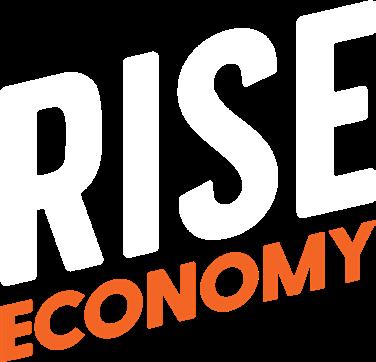

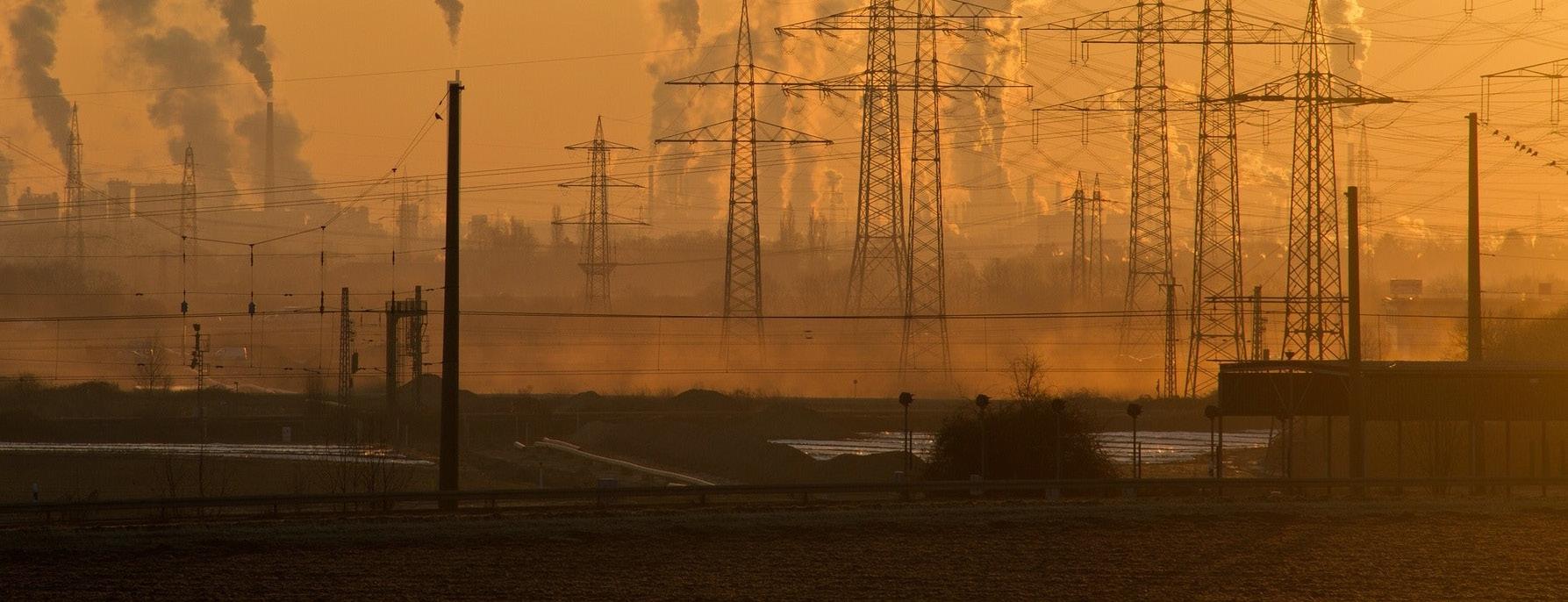
Jamie Buell, Research Analyst
Kevin Stein, Chief of Legal and Strategy
California communities have been ravaged by fires, flooding, extreme heat and paralyzing spring snowstorms. Big changes in public policy and corporate conduct are needed to solve the crisis of climate change. This report analyzes the Paycheck Protection Program (PPP), a public-private initiative created in 2020 to help alleviate financial pressures businesses experienced during the COVID-19 pandemic, and highlights the unexpected impacts the loan program has had on climate change. This first-of-itskind analysis looks at all bank financing of oil, gas and coal companies under the PPP. Here are some key takeaways from our analysis:
f Under the PPP, financial institutions made thousands of loans to fossil fuel companies, totaling nearly $6 billion in funding, and collecting more than $178 million in fees paid out by the Small Business Administration.
f Three of the nation’s largest banks – Wells Fargo, JP Morgan Chase and Bank of America – did a substantial amount of PPP lending to oil and gas companies nationally as well as in California.
f Certain smaller banks, like Frost, Zions and Prosperity, were also some of the top national lenders to oil and gas companies.
f Tri Counties Bank dominated PPP lending to oil and gas operations in California, by both loan count and dollar volume.
f The most popular oil and gas sub-sectors among banks’ PPP lending portfolios were “Support Activities for Oil and Gas Operations,”“Crude Petroleum Extraction,” “Drilling Oil and Gas Wells,” and “Natural Gas Extraction.”
f Twenty banks lent nearly $115 million to private equity-backed oil, gas and coal extraction companies. The PPP was designed to support small businesses that had no place else to turn to stay afloat. Private equity-backed firms should not have been allowed to jump the queue to access limited federal funding.
The PPP program was meant to help struggling small businesses and their employees:
The Paycheck Protection Program (PPP), established by the CARES Act, was implemented by the Small Business Administration (SBA) with support from the Department of the Treasury. The first round of funding was available to small businesses on April 3, 2020, and the second round was available on January 19, 2021. The program ended on May 31, 2021. This program provided small businesses with funds to pay up to eight weeks of payroll costs including benefits. Funds could also be used to pay interest on mortgages, rent and utilities. The PPP was intended to prioritize millions of Americans employed by small businesses by authorizing up to $659 billion toward job retention and other expenses. Small businesses and eligible nonprofit organizations, Veterans organizations and Tribal businesses, as well as individuals who are self-employed or independent contractors, were eligible if they also met program size standards.1
The design of the program and early implementation have raised public and policy concerns with the PPP:
Rise Economy, formerly the California Reinvestment Coalition (CRC), and other groups nationwide raised concerns early on that the PPP was not designed or implemented to meet the needs of small businesses most impacted by the COVID-19 pandemic, and
1 https://home.treasury.gov/policy-issues/coronavirus/assistance-for-small-businesses/paycheck-protection-program
may have reinforced redlining and exclusionary bank practices by favoring existing bank customers.2
Early reports on the program highlighted how initial funding went to existing bank customers and did not reach communities of color that were most affected by the pandemic and least likely to have banking relationships.3
Further, analysis by the Private Equity Stakeholder Project4 identified a number of private equity-backed companies that received PPP funds. Overlaying their analysis with ours, we found that 29 banks5 originated $114,827,668 in PPP funds to 50 oil, gas and coal extraction companies that were private-equity backed. These PPP recipients all had access to private equity capital, and therefore did not need to take advantage of the limited funds represented by the PPP. As such, the SBA attempted to restrict private equity participation in the PPP.6 These companies should not have needed to, and should not have been able to, rely on and receive PPP funding. PPP loans that went to private equity-backed energy companies resulted in fewer loans to mom-and-pop small businesses struggling to survive the pandemic, keep their employees and support their communities.7
2 https://calreinvest.org/press-release/advocates-call-for-monitoring-to-ensure-relief-is-reaching-immigrant-owned-and-small-businesses-of-color/
3 https://www.cnbc.com/2020/10/16/treasury-encouraged-banks-to-prioritize-ppp-loans-for-existing-clients.html
4 https://pestakeholder.org/news/ppp-loans-flow-to-energy-companies-backed-by-deep-pocketed-private-equity-2/
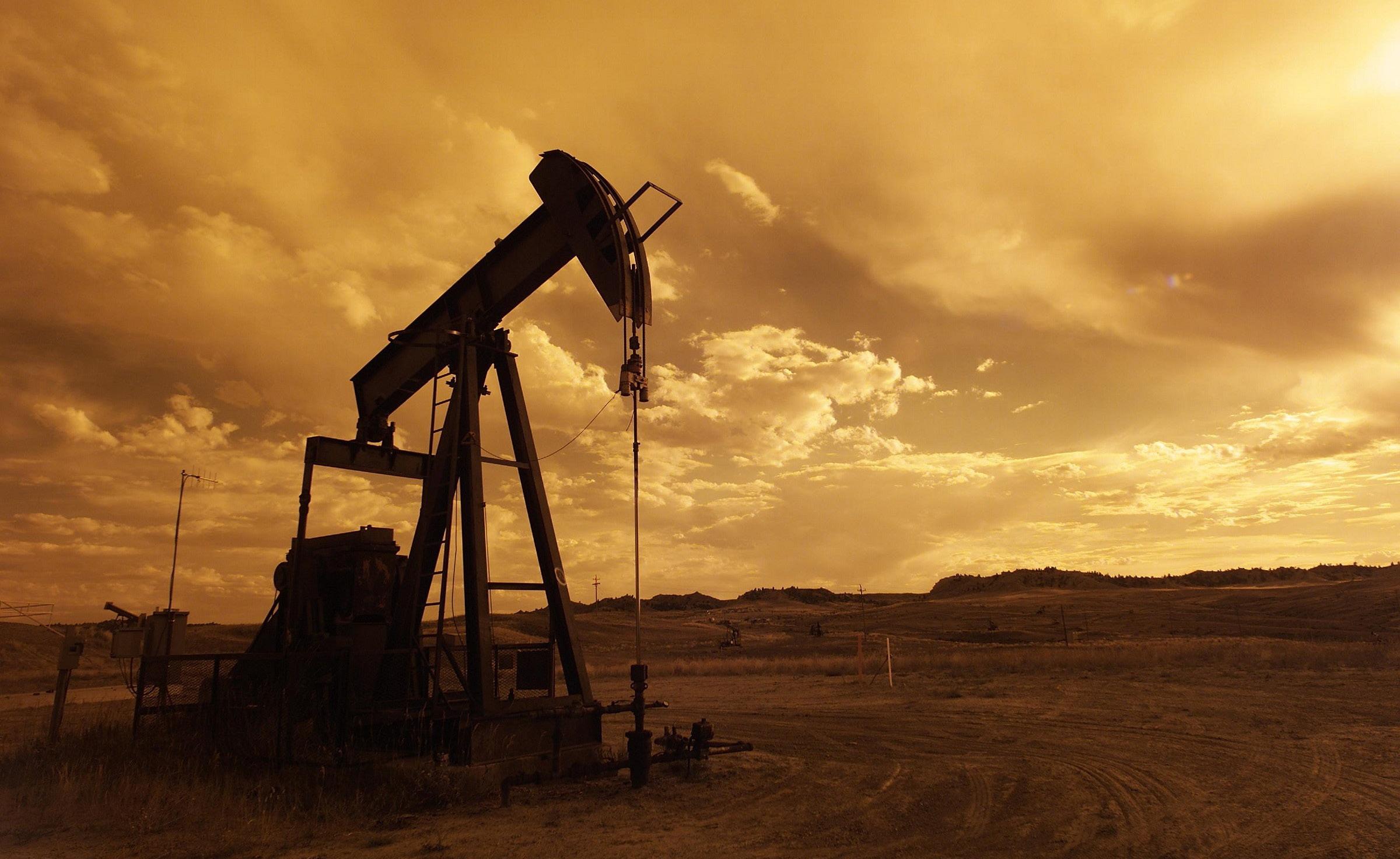
5 The banks that originated PPP loans to private equity backed energy companies as identified by the Private Equity Stakeholder Project (in order with the highest volume lender first), were: Cadence Bank, Gulf Capital Bank, Amarillo National Bank, PNC Bank, Home Bank, Bank of Colorado, MidFirst Bank, West Texas National Bank, Zions Bank, First Horizon Bank, Origin Bank, JPMorgan Chase Bank, N.A., United Community Bank of North Dakota, Watermark Bank, Silicon Valley Bank, Vantage Bank Texas, Midwest Regional Bank, b1BANK, Vista Bank, First National Bank of Louisiana, UMB Bank, National Association, Commerce Bank, First National Bank and Trust Company of Weatherford d/b/a First Bank Texas BancFirst, BOKF, National Association, American State Bank & Trust Company of Williston, First State Bank, Transportation Alliance Bank, Inc. d/b/a TAB Bank, Simmons Bank
6 https://www.politico.com/news/2020/04/24/investment-firms-barred-small-business-aid-coronavirus-206523
7 For Private Equity Stakeholder Project analysis, see: https://pestakeholder.org/news/ppp-loans-flow-toenergy-companies-backed-by-deep-pocketed-private-equity-2/
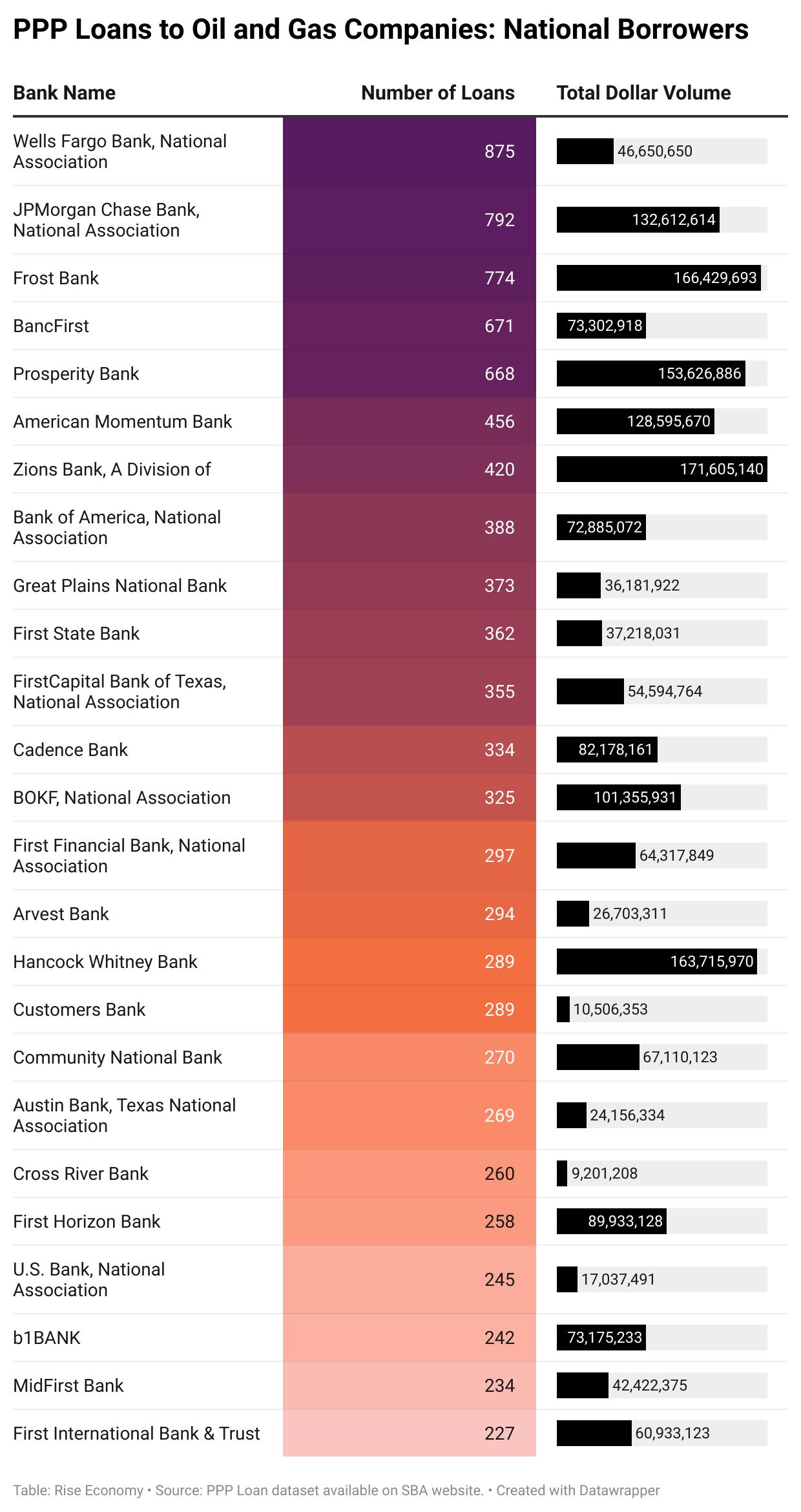
Who received PPP loans?
The “Mining, Quarrying and Oil and Gas Extraction” sector8 (oil and gas) did:
While there have been several analyses of the PPP, we believe this is the first to look at bank PPP financing of oil and gas-related companies.
Under the PPP, financial institutions made thousands of loans to fossil fuel companies, totaling nearly $6 billion in funding.9 These financial institutions collected over $178 million in fees.
The following analysis focuses on the top 25 lenders to oil and gas companies nationwide. These lenders provided nearly $2 billion in PPP loans to oil and gas operations across the country.
While the nation’s biggest banks, like Wells Fargo and JP Morgan Chase, were at the top of the list for oil and gas PPP loans according to loan count, some banks lent more money in total to oil and gas companies despite making fewer loans. Zions Bank, for instance, made half the number of loans that Wells Fargo made, and yet their oil and gas PPP loans totaled nearly $125 million more in dollar volume. To provide more granularity, we focus on the top two lenders by loan count to mining, oil and gas extraction companies:
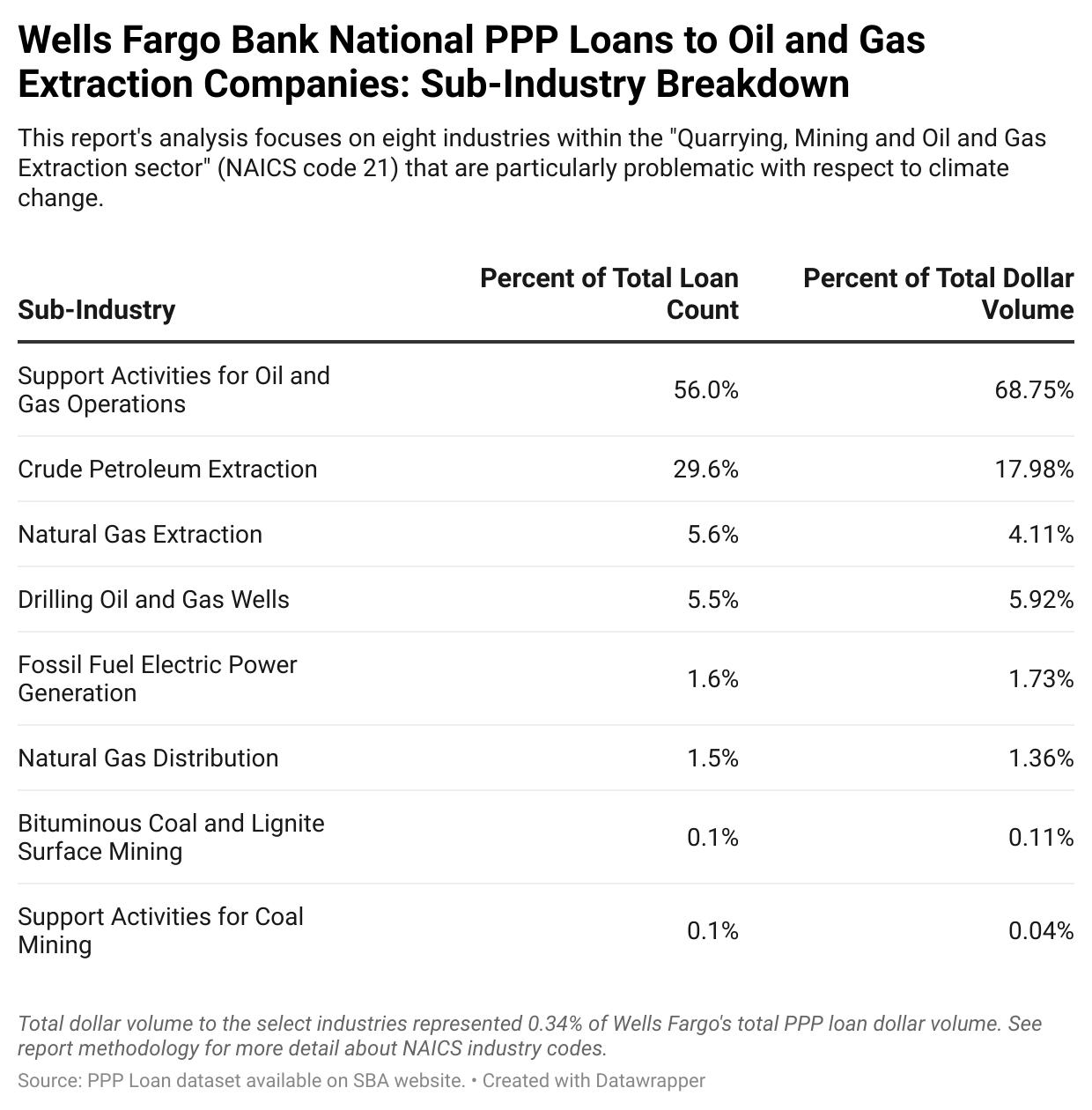
8 See methodology for more information about the NAICS industries of focus for this report’s analysis.
9 The identified 6-digit NAICS industries that are the focus of this analysis represent 0.75% of total PPP dollar loan volume ($789 billion). There are 1,270 6-digit NAICS industries present in the PPP loan dataset. Fully 1,242 industries similarly represent less than 1% of the total dollar volume of PPP lending.
The sub-industry “support activities for oil and gas operations,” made up the majority of Wells Fargo’s PPP loans to the oil and gas sector, and also represented an even higher portion of its dollar volume to the oil and gas sector.
The sub-industries “natural gas extraction” and “drilling oil and gas wells” made up a larger percentage of JP Morgan Chase’s dollar volume lending to the oil and gas sector than its loan count, illustrating that Chase PPP loans to these two sub-sectors were of a higher dollar value.
The PPP provided a fee structure that rewarded lenders for originating smaller-sized PPP loans. Rise Economy, while recognizing that many lenders worked hard to get PPP funds out the door and on the street to small businesses, has also raised concerns that the program provided a taxpayer-subsidized windfall to lenders for making no-risk loans. Rise Economy called on banks to donate PPP fees earned to nonprofit organizations in communities meant to benefit from the program. The chart below reflects an estimate of the lenders garnering the largest share of PPP loan fees.
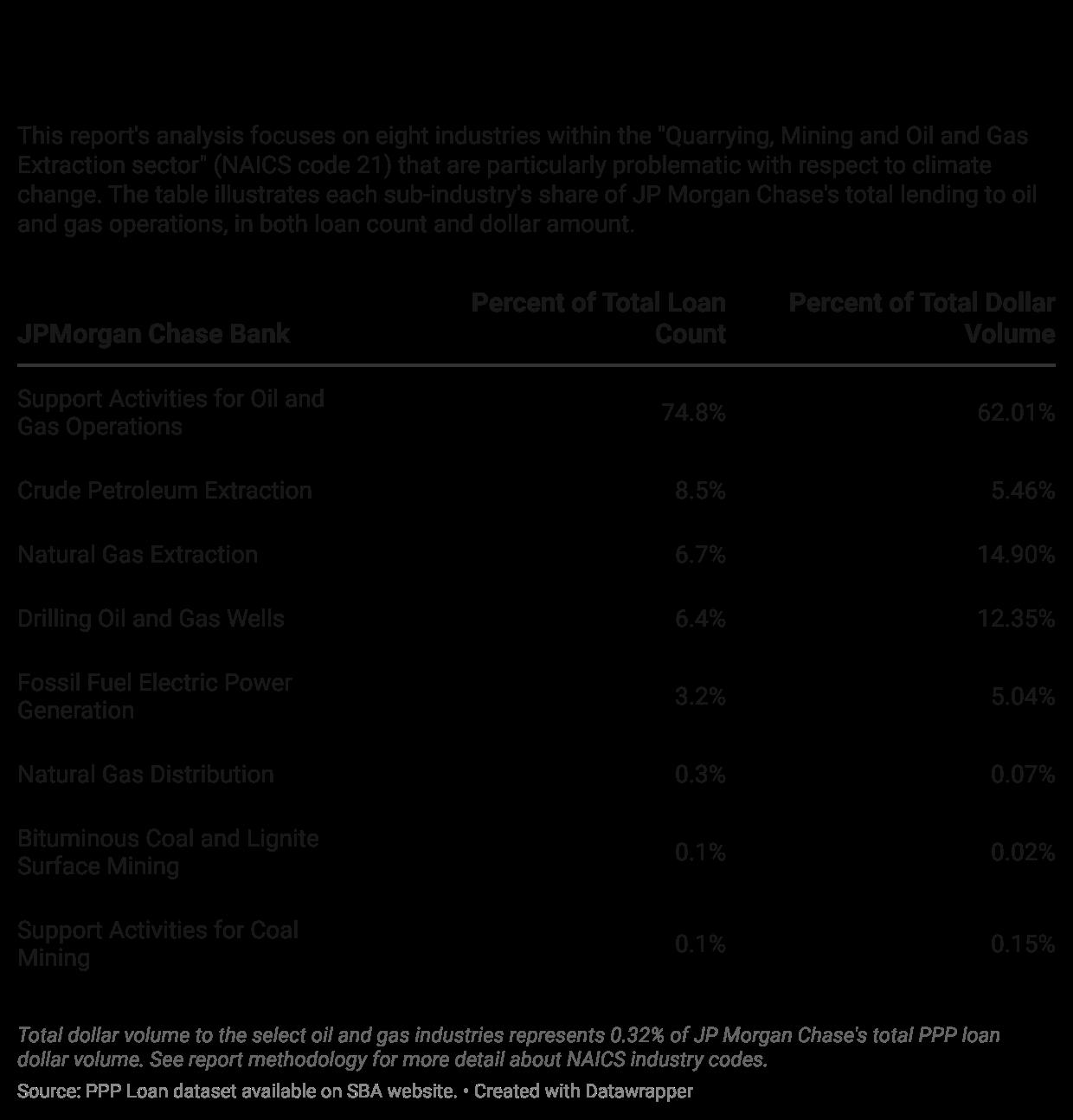
The top 25 lenders according to fee revenue generated from PPP lending accumulated a total of $59.15 million from their support of oil and gas operations.
The following analysis focuses on PPP lending to California-based borrowers. We focus the scope on the top 20 financial institutions instead of top 25, as the top 20 did the majority of California-based lending in both loan count and dollar volume.
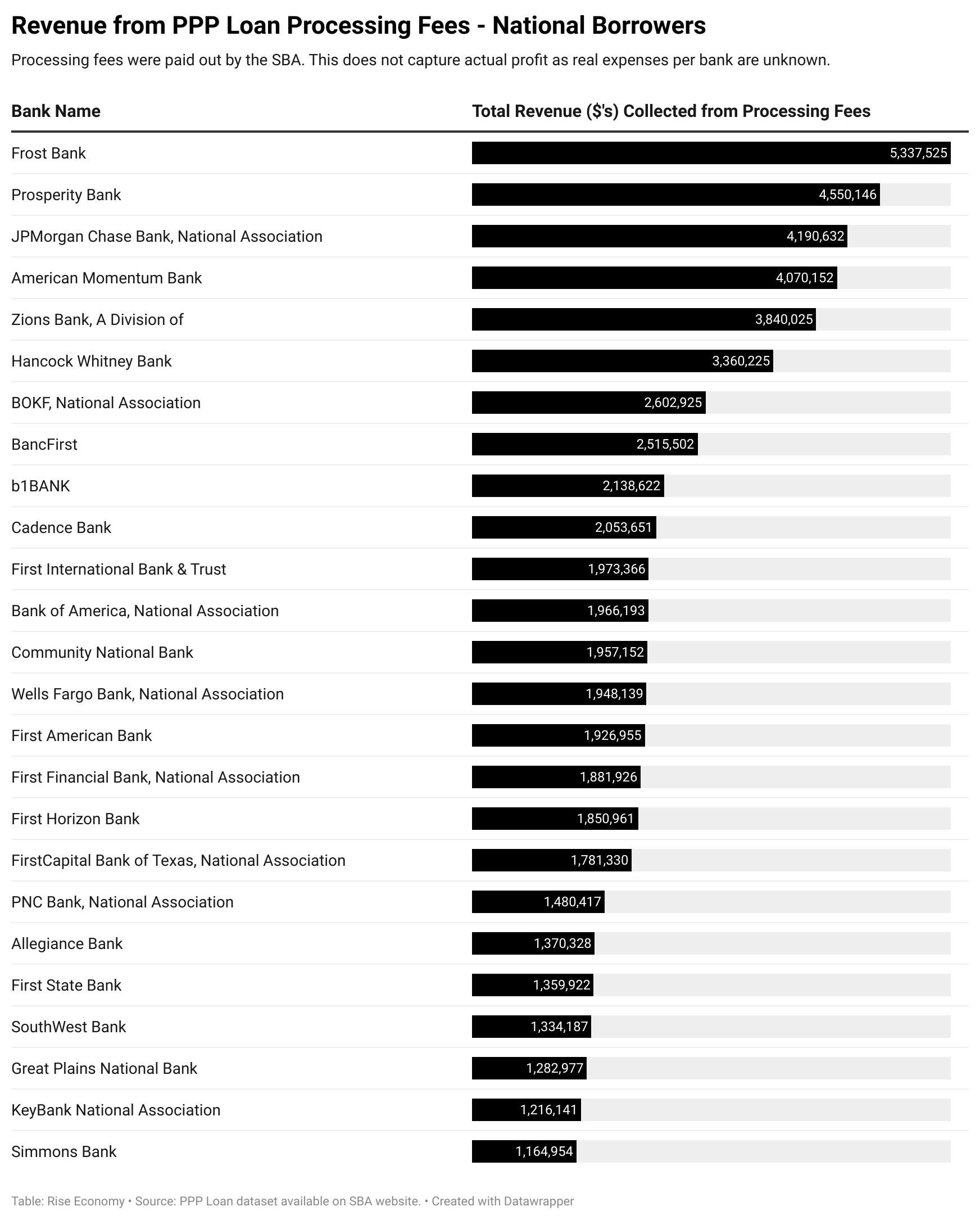
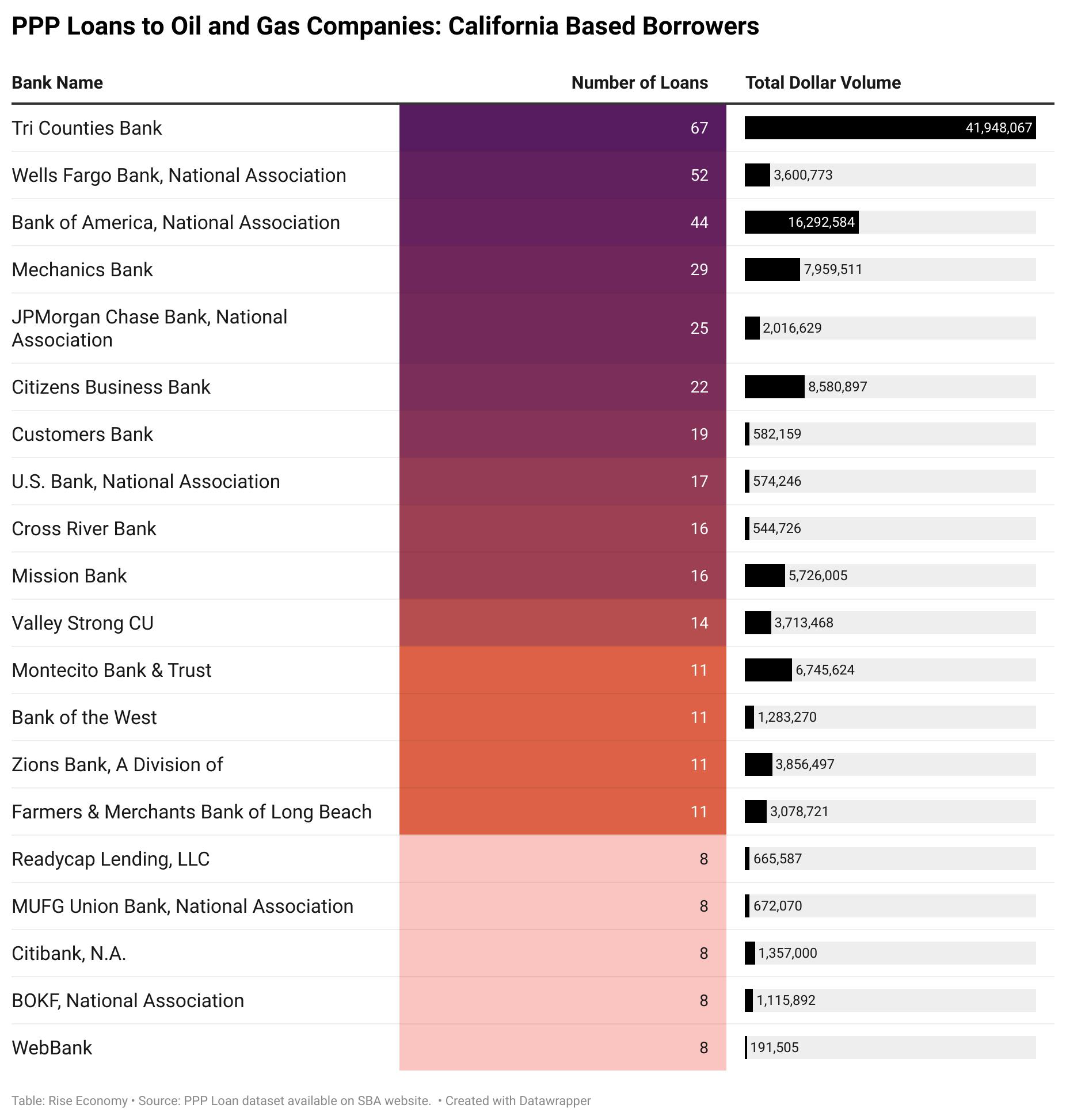
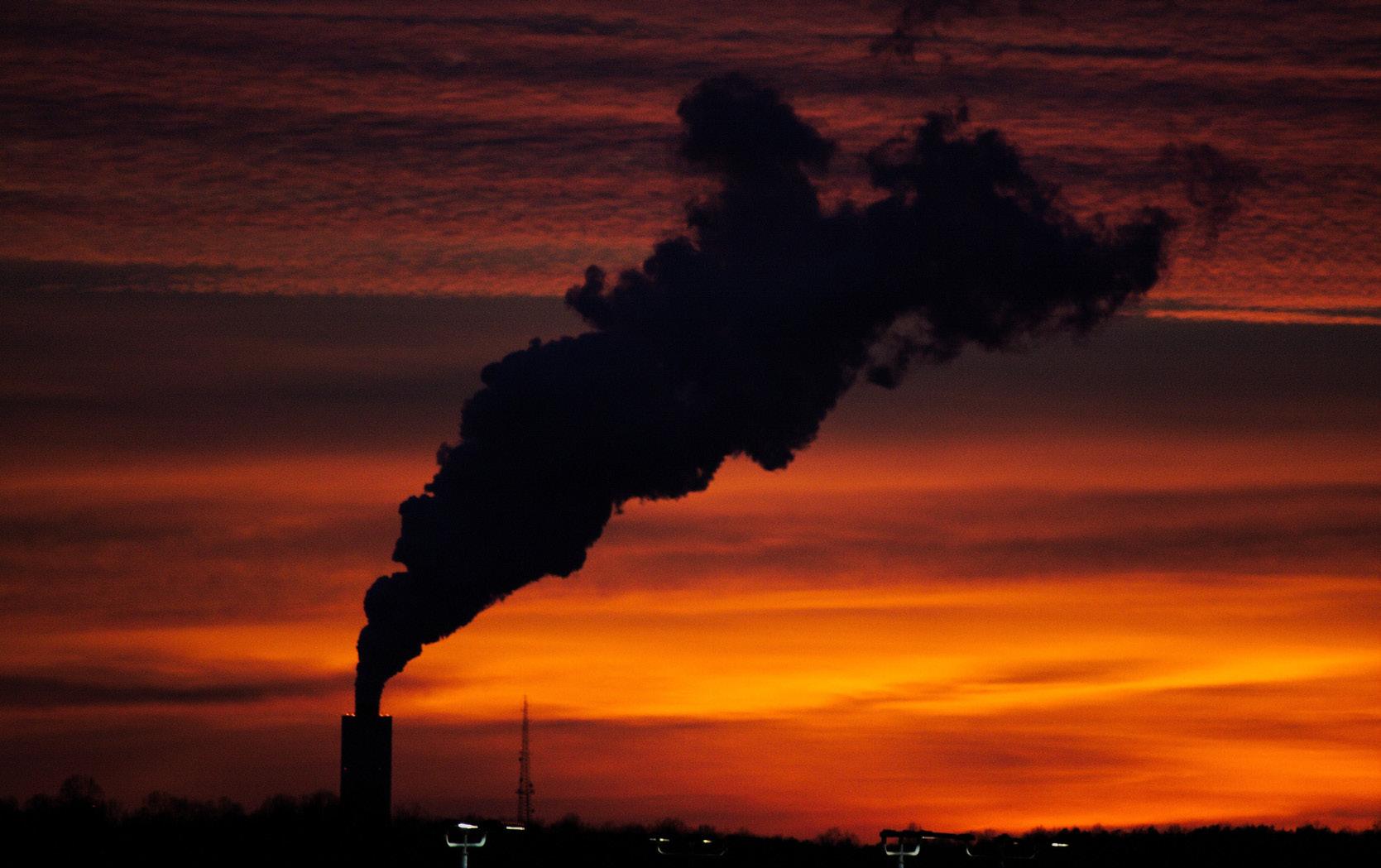
Not only did Tri Counties Bank originate the largest number of PPP loans to oil and gas companies in the state, but they also lent the most in dollar volume by far. While only making 15 more loans than Wells Fargo, Tri Counties originated $38 million more in PPP loans to oil and gas companies in California than Wells Fargo.
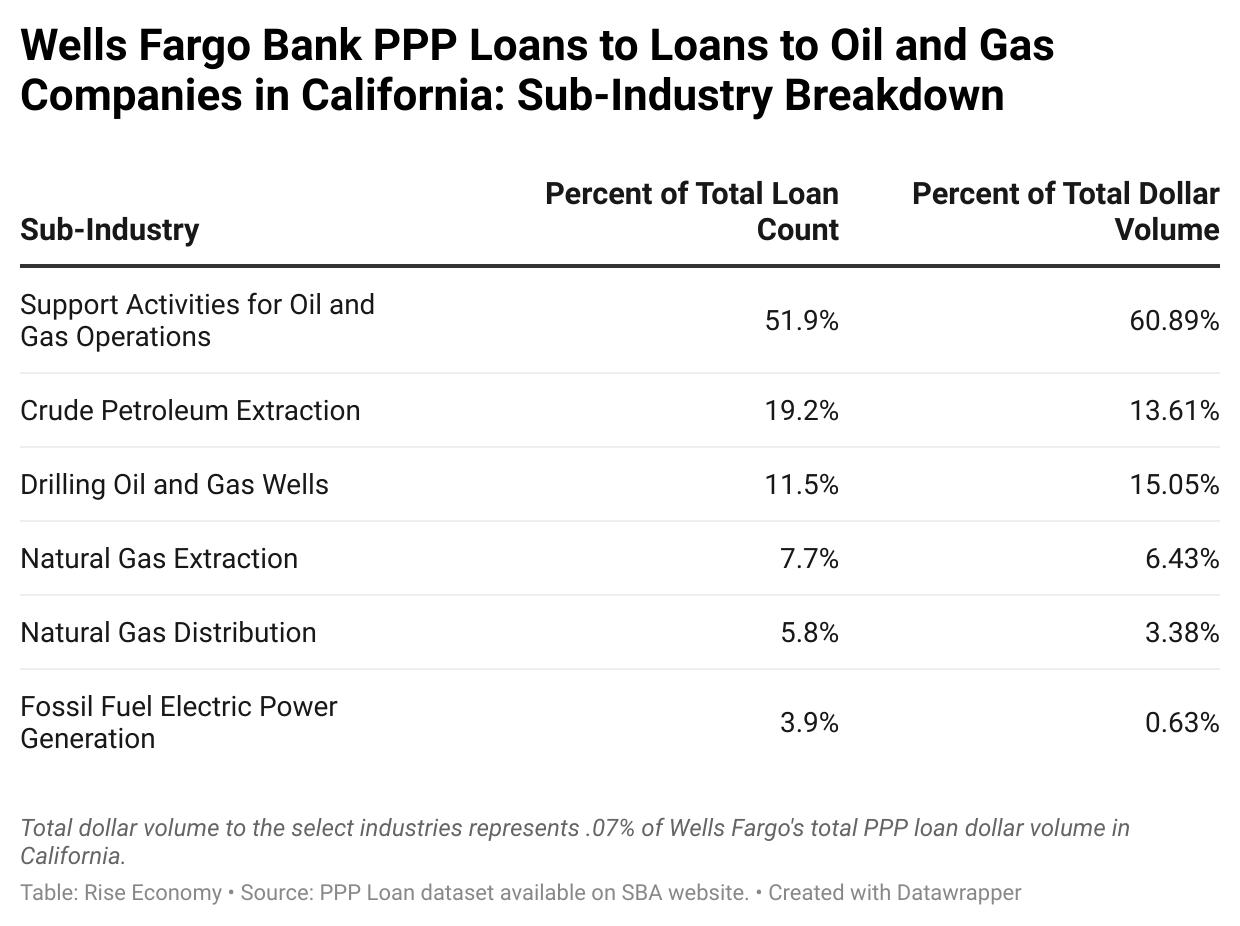
Additionally, Tri Counties Bank’s PPP loans also represented a larger share of their total PPP dollar volume compared to Wells Fargo.
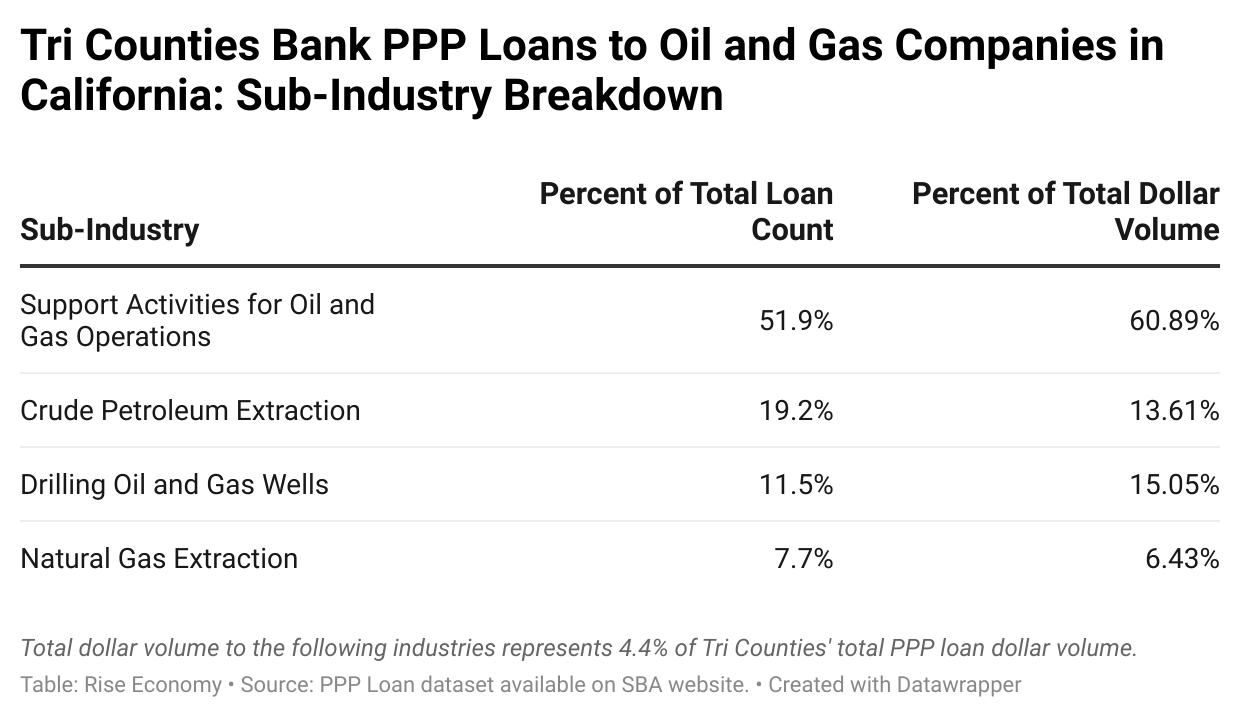
The top 20 lenders according to fee revenue generated from PPP lending accumulated a total of $3.47 million from their support of oil and gas operations in California.
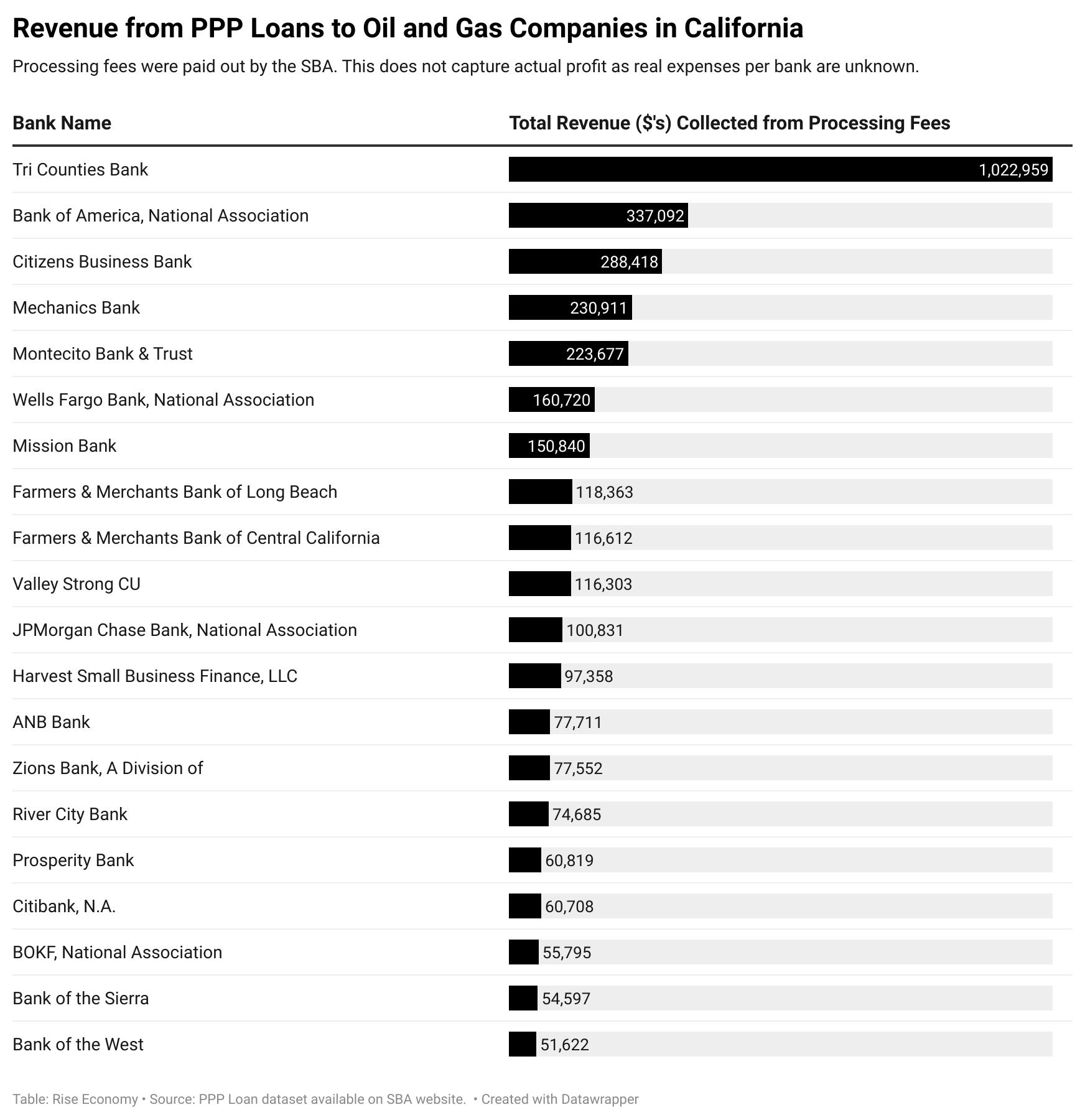
It’s not just the PPP that delivered federal pandemic relief dollars to oil and gas companies
The Federal Reserve’s Main Street Lending Program was a COVID-19 relief program designed to “support lending to small and medium-sized for-profit businesses and nonprofit organizations.”10 Yet, data analyzed by Bailoutwatch11 found 58 banks provided more than $2.2 billion in financing to oil and gas companies – representing 13% of total funds dispersed by the program, far more than the share of PPP lending represented by the eight industries highlighted in this report.
10 https://www.federalreserve.gov/monetarypolicy/mainstreetlending.htm
11 https://bailoutwatch.org/data
Federal and state policy must move bank financing away from fossil fuels and towards communities and workers
The PPP was meant to support small businesses struggling to survive and to pay workers during the COVID-19 pandemic. The program failed to adequately serve the businesses and communities most in need, while oil and gas extraction companies were able to benefit. On top of threatening our climate and posing a climate-related financial risk to banks, their customers and our economy, the oil and gas industry is also heavily subsidized. By at least one estimate, the oil and gas industry currently receives nearly $15 billion in subsidies from the U.S. government each year.12
Meanwhile, a recently released report by the Intergovernmental Panel on Climate Change highlights the dire climate situation and grave threats we are facing. The report notes, “the world is likely to pass a dangerous temperature threshold within the next 10 years, pushing the planet past the point of catastrophic warming — unless nations drastically transform their economies and immediately transition away from fossil fuels.”13

California debates oil and gas windfall profits
While working families struggle to keep businesses open and pay their bills, oil and gas companies have earned record profits. In September 2022, California Governor Gavin Newsom proposed a windfall tax on oil companies, which reportedly made nearly $100 billion in profits over a three-month period.14 On March 28, 2023, the Governor signed the Gas Price Gouging Law.15
Climate concerns in California grow amidst increasing fires and floods.
Climate change impacts on California are growing and becoming increasingly alarming. A report released last summer by the state’s nonpartisan Legislative Analyst’s Office painted a grim picture of a California subject to jarring resident death estimates and
12 https://www.theenergymix.com/2023/04/02/orderly-climate-transition-needs-fossil-fuel-bans-phaseouts-authors-say/
13 https://www.washingtonpost.com/climate-environment/2023/03/20/climate-change-ipcc-report-15/
14 https://www.gov.ca.gov/2022/09/30/governor-newsom-calls-for-a-windfall-tax-to-put-record-oil-profits-back-in-californians-pockets/
15 https://www.gov.ca.gov/2023/03/28/governor-newsom-signs-gas-price-gouging-law-california-tookon-big-oil-and-won/
worker health impacts due to smoke and extreme heat, school closures, lost housing and billions of dollars in property damage due to rising sea levels.16 And these reports were released before California suffered further devastating fires, record rain levels and flooding, and other extreme weather events.
Of paramount concern to Rise Economy is the devastating impact that climate change is having on people and communities, especially Black, Indigenous, and People of Color (BIPOC) communities which are disproportionately affected by floods, fires and extreme heat and weather, and the loss of life, quality of life they bring. These impacts and imperatives should be enough to compel policy change to better protect our environment and our communities against further oil and gas extraction activities and the bank financing that fuels it.
Bank financing of oil, gas and coal not only hastens harmful climate change, it also impacts the health of our financial system. Banks are vulnerable to climate-related financial risk in the form of a) transition risks that could leave banks holding worthless oil and gas assets as the nation and world transition to a greener economy, as well as b) physical risks, as more property securing loans are destroyed by climate disasters, leaving borrowers unable to pay back loans.17
The imperative to transition is true for all banks, including smaller community banks, which have not been the subject of recent bank regulatory efforts but are nonetheless vulnerable to concentrated risks.18 Yet there is no question that the biggest banks - especially Bank of America, Citibank, JPMorgan Chase and Wells Fargo - are responsible for the lion’s share of fossil fuel finance.19 All banks need to transition to a green, fossil-free economy. For their sake, as well as ours.
Recommendations for moving toward a green economy that protects communities, jobs, the environment and financial stability
To meet the critical climate challenges of today, banks must commit to:
1 No funding of new oil, gas or coal expansion activities. This includes halting all: direct financing for new upstream projects (exploration, production, or extraction of natural gas, oil, and coal) or midstream infrastructure that will service new upstream projects; and corporate finance for any company planning to commit a material portion of capital expenditures (CAPEX) to the development of new upstream projects.
2 Disclosing of fossil fuel finance, firm-level emissions and portfolio-wide financed emissions (including Scopes 1, 2 and 3 emissions), and community impacts.
3 Increased funding of climate resiliency, renewable energy and environmental sustainability initiatives in BIPOC communities that exceed funding of oil and gas activities. Ensure that any and all profit made from PPP lending to oil and gas companies is reinvested in this way.
4 Development of credible and robust climate transition plans that show exactly how banks and their fossil fuel clients will get to net zero, with measurable benchmarks along the way.
16 https://calmatters.org/environment/2022/04/california-climate-change-report-legislature/
17 See, https://calreinvest.org/press-release/crc-and-over-50-organizations-submit-letter-opposing-luther-burbank-savings-washington-federal-bank-merger/
18 https://greencentralbanking.com/2023/03/17/silicon-valley-bank-climate-risk-federal-reserve/
19 https://www.bankingonclimatechaos.org/
5 No blue-lining – banks cannot fund climate chaos and then deny, or raise pricing on, mortgage, small business, affordable housing or other loans because communities are deemed too climate-risky.20 This is especially true as communities of color are most vulnerable to climate disasters. Banks need to develop due diligence procedures and conduct regular reviews to ensure they are not violating fair housing and fair lending laws and principles.

6 Align policy and direct and indirect lobbying activities with the Paris Agreement goal to limit global temperature rise to 1.5 degrees Celsius and disclose those efforts.
7 Develop due diligence standards to respect and protect the rights of Indigenous Peoples and local communities. Provide a mechanism for community voices and all stakeholders to be heard and to inform bank efforts.
8 Support small businesses that were meant to benefit from the PPP, not provide multi-million dollar loans to multi-million dollar businesses – especially those backed by private equity. Banks must fund smaller and BIPOC-owned businesses that may require smaller dollar loans. Instead of being seen by banks merely as providing lower returns, these loans bolster community stability as small, local businesses hire locally, help build household wealth and provide the backbone of local neighborhoods.
9 Ensure a just transition by supporting workers and communities that are reliant on emission-intensive industries that must be phased out. Provide funding for job training for the new jobs that will be increasingly needed in an increasingly green economy. Ensure that new green jobs and businesses are built in communities most impacted by a legacy of redlining, environmental racism and discrimination.
20 A research report released by the Federal Reserve Bank of Chicago, using supervisory data providing loan-level portfolios of the largest U.S. banks, found that banks significantly reduced lending to areas more impacted by climate change starting around 2015. Ralf R. Meisenzahl, “How Climate Change Shapes Bank Lending: Evidence from Portfolio Reallocation,” March 30, 2023
And in order for all this to happen, regulators must move to require these bank commitments in the form of:
1 Community Reinvestment Act (CRA) rules should not only favor bank financing of climate resiliency in low-to-moderate income and BIPOC communities but should also downgrade banks for fossil fuel and climate change finance and blue-lining which exacerbate community credit needs and may run afoul of fair housing and fair lending obligations.
2 Tighter bank supervision and the development of Principles for Climate-Related Financial Risk Management, which the three banking regulatory agencies should move forward quickly. Supervision, oversight and principles should create an expectation of robust transition plans with measurable benchmarks, and extend to financial institutions of all sizes.
3 Bank Merger Act reform should elevate climate concerns under systemic risk and convenience and needs analysis, and must ensure that bank mergers do not lead to further concentration of climate-related transition and physical financial risk.
4 SEC Climate Disclosure Rules should include Scope 3 emissions reporting requirements for all companies to bring needed transparency to the question of which financial institutions are moving us toward a just transition, and which are not.
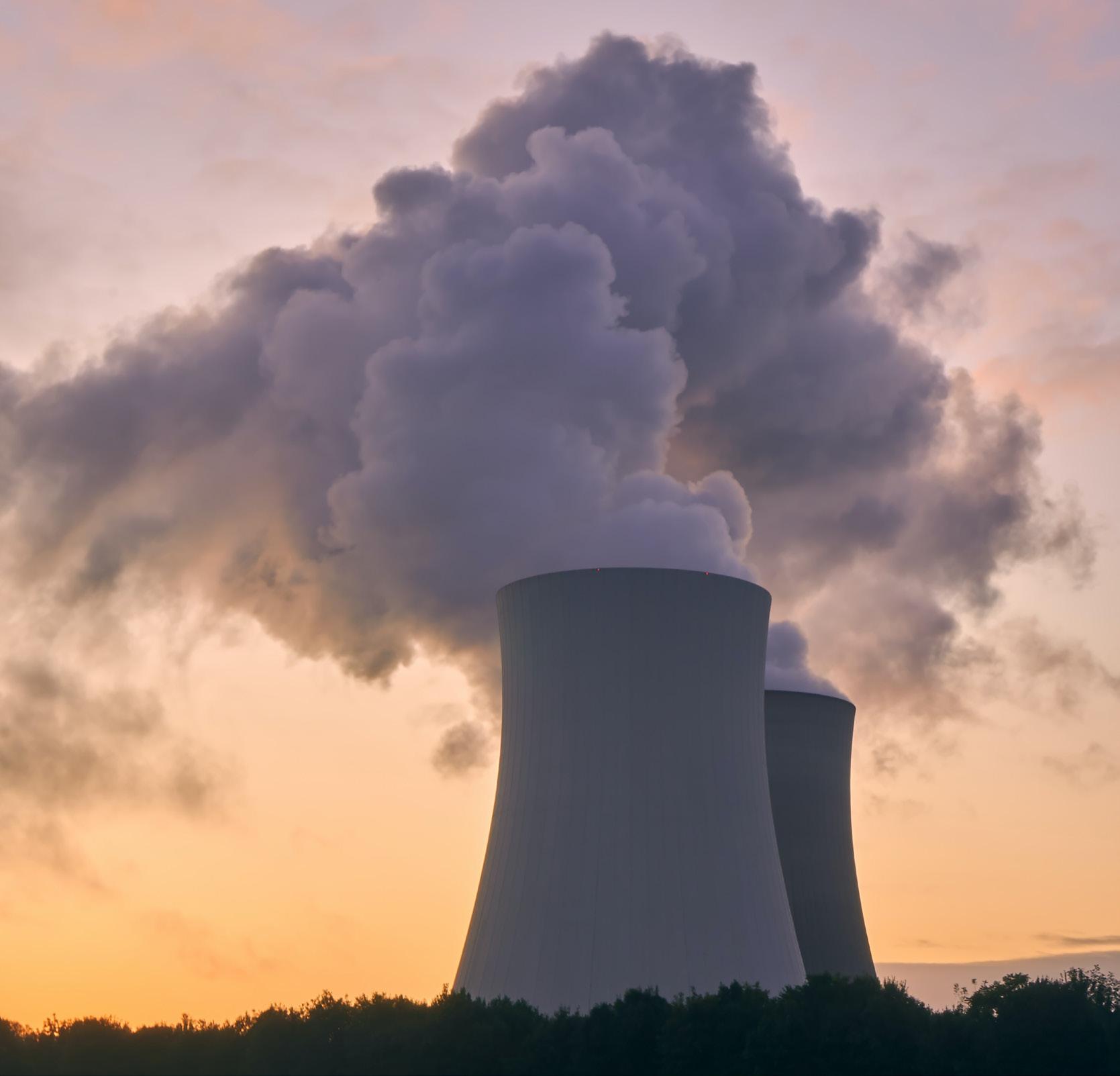
Methodology
This analysis looks at publicly available PPP data obtained through the SBA website and focuses on all lending to businesses identified with certain NAICS Code numbers. We focus this analysis on specific businesses under NAICs Code 21 – the Quarrying, Mining and Oil and Gas Extraction sector – and NAICS Code 22 – the utility sector – which were identified to be particularly problematic and substantially contributing to the climate crisis by perpetuating our dependence on fossil fuels21 The following 6-digit NAICS code industries are included in the analysis:
f Crude Petroleum Extraction (211120)
f Natural Gas Extraction (211130)
f Bituminous Coal and Lignite Surface Mining (212111)
f Bituminous Coal Underground Mining (212112)
f Drilling Oil and Gas Wells (213112)
f Support Activities for Coal Mining (213113)
f Fossil Fuel Electric Power Generation (221112)
f Natural Gas Distribution (221210)
The PPP processing fee structure, paid out by the SBA, had some modifications throughout the different phases of the program22. For our analysis, we used the fee structure used for the First Draw of PPP lending which is as follows:
f Five (5) percent for loans of not more than $350,000;
f Three (3) percent for loans of more than $350,000 and less than $2,000,000; and
f One (1) percent for loans of at least $2,000,000.
Revenue was calculated per loan, according to loan approval amount size, and then summed per institution. Since the costs on the bank side are unknown, these numbers are basic estimates of revenue and not necessarily the real profit banks made off of PPP lending.
21 Special thanks to April Merleaux from RAN who helped identify business NAICs codes of concern.
22 https://www.sba.gov/sites/default/files/2021-02/Procedural%20Notice%205000-20091%20-%202nd%20 Updated%20PPP%20Processing%20Fee%20and%201502%20Reporting-508.pdf
